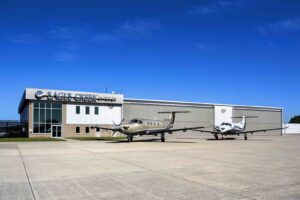The SARS-2 virus, COVID-19, or whatever name you choose has kept you grounded until now. But it is finally time to go fly.
Think about how long the aircraft has been sitting and how many gremlins may have possibly infested the aircraft. Was the aircraft covered, protected, closed up, plugged etc.? Let’s take a walk around and see where we could possibly have troubles.
Piston Commanders can have uninvited squatters in the engine cowlings building nests of straw and dried grasses between the cylinders, just waiting to catch on fire after the engines get up to operating temperatures. In the past we have removed truly amazing quantities of straw that the birds have stuffed into the nacelles. (I recall completely filling two of our large shop trash cans with straw stuffing from one aircraft that sat for two months.) Birds building nests in the bottom portions of the nacelles are easily detectable on a good preflight inspection. You did look, right?
Turbine Commanders can have birds wriggle their way into the nacelles as well. They will enter through the upper cowling vents, with the same potential for flaming results. Birds, snakes and other critters have been found lurking in the nacelle spaces above the wing—that space formed by the hump behind the firewall in either piston or turbine Commanders.
Both piston Commanders and early turbo Commanders can have mud-dauber wasps build nests in the vacuum ejector port on the right side of the fuselage. Think about what will happen if that instrument and wing boots vacuum system ejector port is clogged. We have also heard of little insects clogging pitot tubes. It’s rare, but it has happened, so it’s a good reason to use pitot covers.
If the aircraft was parked outside after the last flight, did you attach the external rudder lock? Or if the aircraft has been pulled out of the hangar for you by helpful FBO staff—did they attach the external rudder lock before pulling it outside? A good time to check for a possible sheared rudder torque tube.
OK, so let’s assume no squatters, no invaders, and the external rudder lock was/is in place. The cowling covers have been removed, pitot covers have been removed, and the nacelles cleared. Does the Nitrogen bottle used for emergency gear extension have a full charge? Did you check the bungee cords for condition?
Let’s move to the nose gear. Anytime the aircraft has been towed, and for every preflight, check that the four little bolts on the bottom of the nose strut holding the steering cylinder in place are secure. And look to see that the castle nut and cotter pin are there, keeping the steering cylinder rod attached to the pin on the steering block.
For the engines check oil levels and the hydraulic reservoir level. (Remember the correct procedure for this check?)
The next checks apply regardless of whether you flew the aircraft last or it just came out of maintenance.
Time to look in the cockpit. First thing is the gear handle down?
Now sit in either cockpit seat. Remove the internal flight controls lock. Hopefully it was installed. Move the flight controls full travel to make sure there is no binding and no strange noises generated.
Starting from the left sidewall look at and touch every control to make sure it is in the position you need it to be in for flight. Both pilots and mechanics have been known to leave them in random positions and not where they need to be for next flight. Work across the instrument panel from left to right. Verify the engines controls are free to move and in the correct position for starting. People have left engine control levers in the wrong position with interesting results. End at the right-hand sidewall and verify you have a full charge of oxygen on board.
OK, so far so good, nothing out of place. For the overhead switch panel start on the bottom row on the left, work to the right. For the top row scan from right to left ending at the battery switch (also do this overhead panel check after every shutdown).
Maybe most important…fuel on board?
Mike Grabbe is an award-winning instructor and technical advisor for Eagle Creek Aviation.





